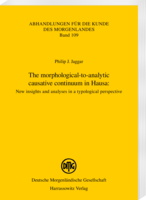|
|
more titles of the subject:
Download:
Please note: With adding digital Products to your cart
the payment will be handled via PayPal. The download will be provided after the payment is confirmed. Over the last few decades, linguists have devoted considerable attention to both homogeneity and variation in the expression of causal events across languages. However, most studies, whether typological or language-specific, have focused on the category of morphologically overt (e.g., ‘lie/lay X down’) causatives, rather neglecting complex periphrastic (e.g., ‘get X to lie down’) formations. The present study addresses this imbalance by elucidating a wide spectrum of causative expressions in Hausa (Chadic/Afroasiatic), supported by a strong cross-linguistic perspective.
It systematically explores, for the first time in an African language, the key design features that distinguish the two mechanisms. Also, it demonstrates that Hausa periphrastic causatives can also differ from each other, e.g., in implicational strength, depending on the modal (TAM) properties of the lower clause. In line with contemporary approaches located within a general typology of causation, the analysis invokes the widely accepted dichotomy between direct and indirect causative constructions. Direct causation associates with morphological causatives, indirect causation with periphrastic expressions – compare morphological ‘I lay X down’ (direct, with no intermediary) with periphrastic ‘I got X to lie down’ (indirect, where X also functions as an intervening actor/cause). Thus, this study provides a rare account of how the two types are used to describe pragmatically different causal events and participant roles. |
|||||||||||||||||||||||||||||||||||||||






